|
|
|||||
|
|
|||||
|
Counter added Sunday, March 25, 2007 -11:00 am Pacific Time
|
|||||
|
|
|
Tuesday, September 18, 2007 – Hot Rod Menace |
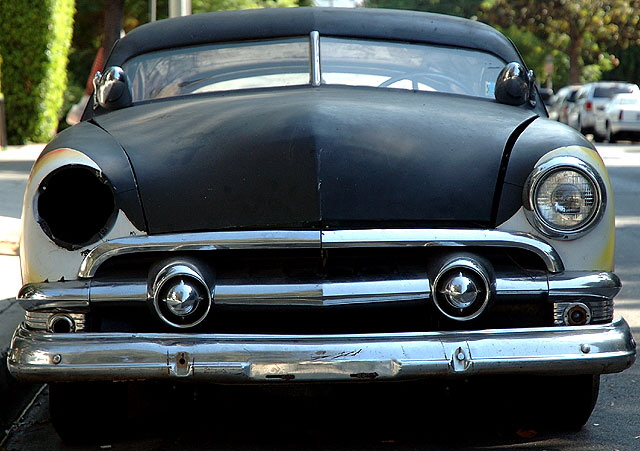 |
|
What appears to be a 1949-51 Mercury coupe, in flat black primer with the flames at the wheel wells, chopped and channeled and done up in the manner of Ed "Big Daddy" Roth – parked here on North Laurel Avenue every day. This was Southern California a few decades ago. This is history, folks. |
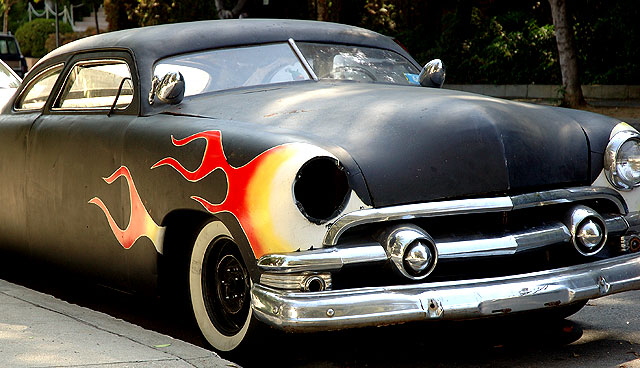 |
||||
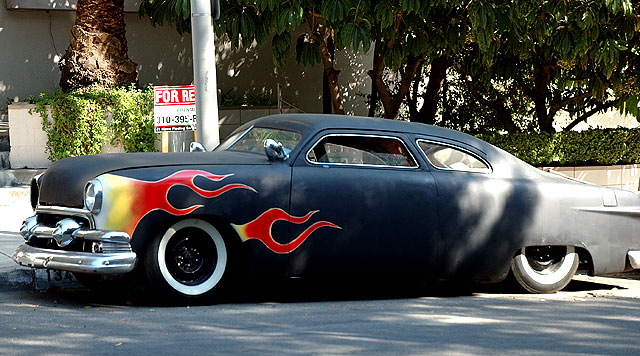 |
||||
|
Chopping: To "chop" a roof the pillars and windows are cut down, lowering the overall roofline. "Chopping the top" goes back to the early days of hot rodding out here – reduce the frontal profile of a car and it should go faster. Some racers on the dry lakes out in the nearby Mojave chopped the tops of their cars so much that the windows were only a few inches tall – you got your "mail slot" windows. Roof chopping became popular with drag racers for the same reason. The first roof chopper is considered to be Sam Barris, who chopped and customized his brand new 1949 Mercury. Barris also pioneered a more advanced form – the B-pillar is removed and you get a "pillarless" hardtop. Channeling: To "channel" a car the body is lowered over the frame by removing the floor and refastening it higher inside the body, so the body rests closer to the ground without altering the suspension. You cannot do this with today's cars that have no ladder frame – now everything is all one piece, welded together. But with the older cars "channeling" was cool – it had the effect of giving the car body a more massive appearance. Channeling is still popular with the hot rod, "leadsled" and mini-truck enthusiasts – the truck guys call this a "body drop." But you need a "body on frame" vehicle to work with. |
||||
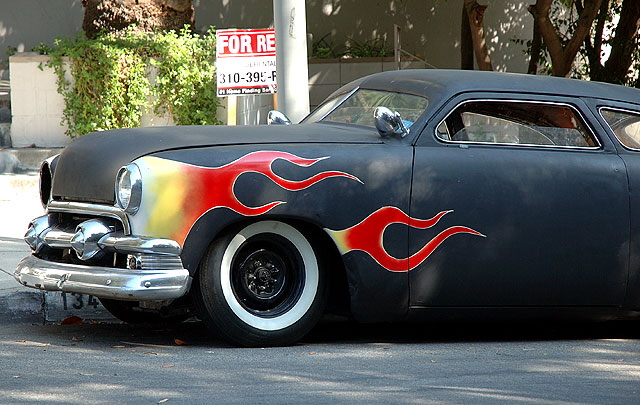 |
||||
|
It has a name – in the 1973 made-for-television movie Hunter (CBS), footage from the Wizard of Oz is used to brainwash a race-car driver and get him to do very bad things. This terrorizes him until he screamed the line – "Stop the monkeys! PLEASE Stop the monkeys!" That's where we get the now-famous pop-culture catch phrase "Please, stop the monkeys!" |
||||
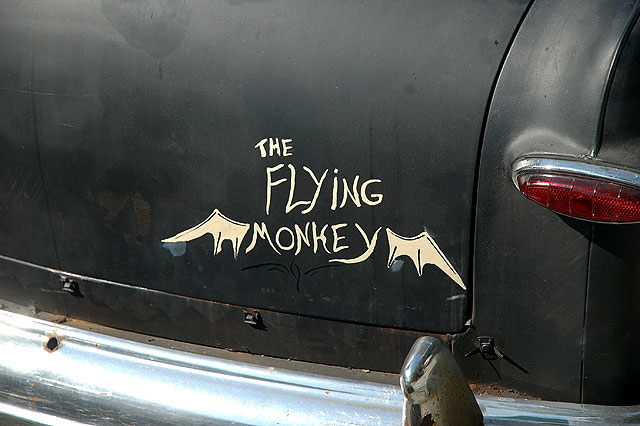 |
||||
|
On the dashboard, the obvious – Rat Fink is one of the several hot-rod characters created by one of the originators of Kustom Kulture, Ed "Big Daddy" Roth. Roth's hatred for Mickey Mouse led him to draw the original Rat Fink. After he placed Rat Fink on an airbrushed monster shirt, the character soon came to symbolize the entire hot-rod/Kustom Kulture scene of the 1950s and 1960s. The Rat Fink is a green, depraved-looking mouse with bulging, bloodshot eyes, an oversized mouth with yellowed, narrow teeth, and a red T-shirt with yellow "R.F." on it. Other artists associated with Roth also drew the character, including Rat Fink Comix artist R. K. Sloane and Steve Fiorilla, who illustrated Roth's catalogs. Rat Fink and Roth are featured in Ron Mann's documentary film Tales of the Rat Fink (2006). Jeannette Catsoulis reviewed in this in The New York Times – Ogling fins and drooling over fenders, the movie traces the colorful history of the hot rod from speed machine to babe magnet and, finally, museum piece and collector’s item. Along the way we learn of Mr. Roth’s lucrative idea to paint hideous monsters — including the Rat Fink of the title — on children’s T-shirts, a sartorial trend that, in the 1960’s, had the added benefit of getting their wearers banned from school, thus giving them more time to play with Mr. Roth’s model car kits. I’ll bet Donald Trump wishes he had thought of that one. More instructive about the obsessions of teenage boys than the allure of steel and wheel, “Tales of the Rat Fink” punctuates Michael Roberts’s eyeball-searing animation with a haphazard selection of old newsreels, photographs and automobile ads. Lending their voices to the cars themselves — a trick Mr. Roth, who died in 2001, might have found a tad cutesy — is an appropriately eclectic bunch of celebrities, including Tom Wolfe (who celebrated Mr. Roth in “The Kandy-Kolored Tangerine-Flake Streamline Baby”) and Ann-Margret, while a strangely listless John Goodman serves as the voice of Mr. Roth. “Cars should have personality,” he tells us, in a tone that suggests he’s struggling to locate his own. Depending on your age, sex and mechanical inclinations, “Tales of the Rat Fink” will convince you that Mr. Roth should either have been canonized or smothered at birth. A Rat Fink revival in the late 1980s and the 1990s centered around the West Coast grunge/punk rock movements. The term fink was originally underworld slang for an informer, comparable to "stool pigeon", and ratfink is an intensified version of "fink." By the time Roth used this name for a character, the term had started to pass into more general usage. It is also thought to have been a toned-down form of "ratfucking," a slang term for playing dirty tricks. See also the Official Ed "Big Daddy" Roth Website, Memoir of Roth by Steve Fiorilla and the Rat Fink Museum. |
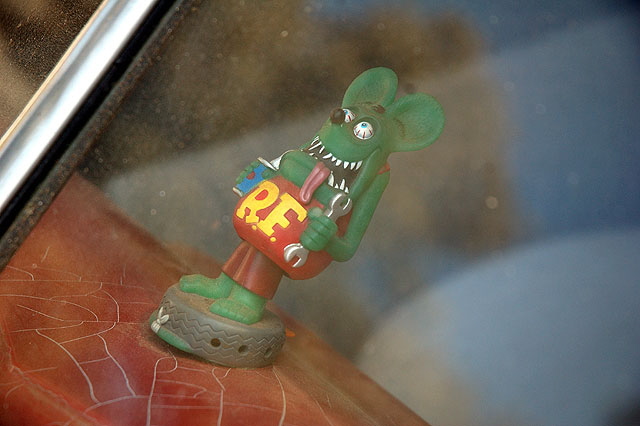 |
|
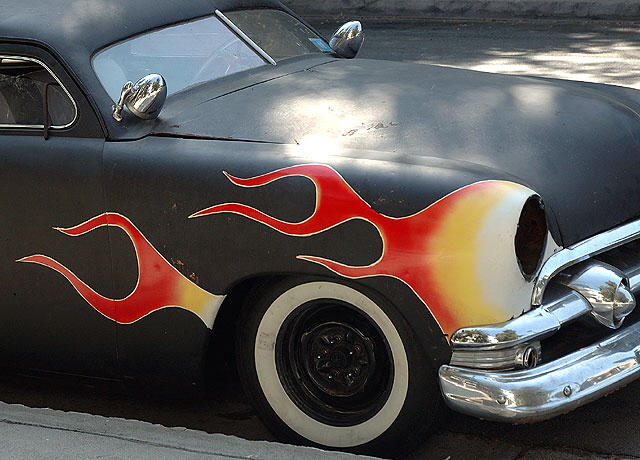 |
|
|
If you wish to use any of these photos for commercial purposes I assume you'll discuss that with me. And should you choose to download any of these images and use them invoking the "fair use" provisions of the Copyright Act of 1976, please provide credit, and, on the web, a link back this site. Technical Note: Most of these photographs were shot with a Nikon D70 - using lens (1) AF-S Nikkor 18-70 mm 1:35-4.5G ED, or (2) AF Nikkor 70-300mm telephoto, or after 5 June 2006, (3) AF-S DX Zoom-Nikkor, 55-200 mm f/4-5.6G ED. They were modified for web posting using Adobe Photoshop 7.0. Earlier photography was done with a Sony Mavica digital still camera (MVC-FD-88) with built-in digital zoom. |
| [Hot Rod Menace] |
|
All text and photos, unless otherwise noted, Copyright © 2003, 2004, 2005, 2006, 2007, 2008, 2009, 2010 - Alan M. Pavlik |
